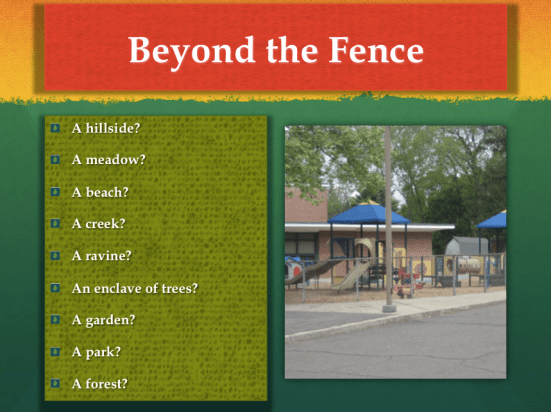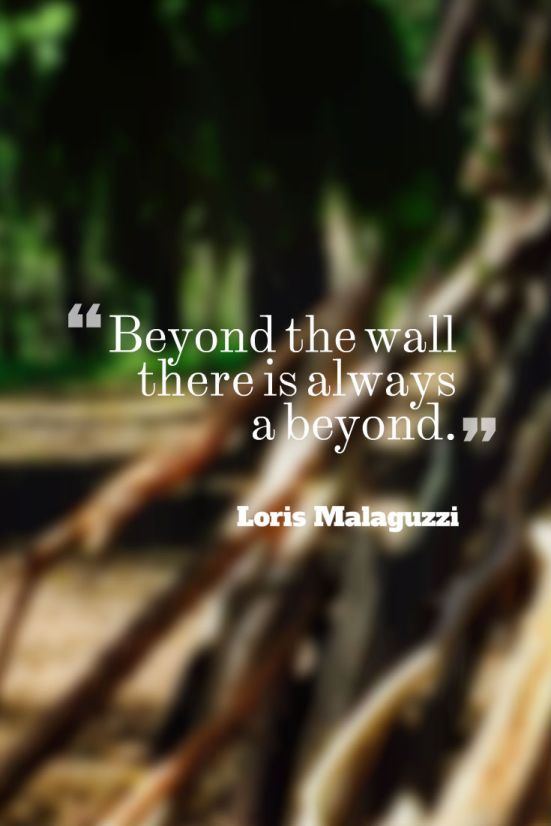By: Diane Kashin, Ed.D, RECE. I would like to make a confession. When I was a practising early childhood educator, I would take children outdoors to a fenced in playground for one hour in the morning and another in the afternoon because outdoor play was required by legislation. It was not my favourite time of day. Often my colleagues and I would huddle together as children played on fixed structures, on tricycles and in the sandbox. We rarely programmed for outdoor play and we never went beyond the fence. Beyond the fence there was a grassy field and trees. It never occurred to us that children would want to play there. Now, in retrospect I know that they would have! Now when I facilitate outdoor play and nature workshops, I share this admission and we discuss what children do when they find themselves in an open field. They run, of course because they can and they should! So now I challenge educators to reflect on what’s beyond their fence?

Beyond the fence, children can develop an emotional connection to a place. This sense of place, will stay with them. They will learn to love what is in that place and as a result you will be helping to shape their ecological identities. The outdoors offers children freedom to do things that they cannot do indoors. The outdoors offers opportunities to experience things that cannot be reproduced indoors such as rain, wind, snow and sun. It is a place to be messy and to make noise. Outside, beyond the fence children will not have to be reminded to use their “walking feet” or their “indoor voices”.

Recently I was asked to facilitate a workshop on outdoor play and nature pedagogy but was cautioned that many of the participants would be from urban settings so they would not have access to nature! But nature is outside – within the fence and beyond! I have been to forest schools and they are magical. On my bucket list is to visit a beach school too! However, you don’t need a forest or a beach to give children opportunities to learn in and with nature. You don’t need a fancy outdoor classroom. All you need is the sky and a belief in what is possible. With children becoming increasingly indoor beings, there is a critical urgency to reverse this trend in the early years. Indoor environments can be aesthetically pleasing and naturalistic. However, nothing replaces the possibilities for play and learning and the health and development benefits of being outdoors. There is always a beyond. Thinking about what is beyond reminds me of this quote from Loris Malaguzzi:

According to Malaguzzi there is a wall, which prevents us from going beyond what we know. When the Hundred Languages of Children Exhibit was in its first incarnation, it was called “When the Eye Jumps Over the Wall.” According to Malaguzzi inside the title there was a message “that the eye, when it looks beyond the wall of habit, of custom, of the normal, of the non-surprise, of assumed security”, will find the possible. When the wall of old habits and customs is broken down the quest for the possible can begin. For Malaguzzi the obstacle to overcome to see beyond the wall is the accepted image of the child. If education is seen as just a service offered to young children, it subjugates the child within a message that their voice need not be heard. The aim of the exhibit for Malaguzzi was to give “shape and vitality to research that vanquishes silence, that affords both children and adults a way to explore, to construct theories and ideas . . .” We can choose to erect the wall that Malaguzzi calls the wall of the “finite” when our responses to curriculum become habituated and left unquestioned, the result is the continuation of dubious practice and a limited view of what is beyond the wall. In the same respect, we can go beyond the fence. We can see the possibilities within our own communities to access what children have a right to experience. If we view the child as an outdoor being, then the possibilities that nature has to offer are endless and essential.
As an educator, I reflected on this writing and wondered…What is my wall? What are my limits and beliefs that hold me back from going beyond the fence? What are the parents’ view on outdoor play outside the perimeter of the fence?
As educators. .how do we view the child?
Great read.Thanks
LikeLike
Hi Diane. When I think about “going beyond the fence” it reminds me that curious, passionate and open-minded educators can cultivate such learning and freedoms for children and themselves if they let go of constraints. Thanks for the post!
LikeLike
Thanks for this post Diane,
Leslie and I have just held our first Nature Connections Through Play network meeting and this was one of the important points we talked about. I will post your blog on the Kawartha Kids Play Outdoors face book page and our web site. Thanks again for the post.
Mary Lou
LikeLike
Pingback: Beyond the Wall: There is Schema Play! | Technology Rich Inquiry Based Research
Pingback: Building Nature Connections in the Early Years | Technology Rich Inquiry Based Research
Pingback: On Being Mindful, Grateful and Joyful: It Matters! | Technology Rich Inquiry Based Research